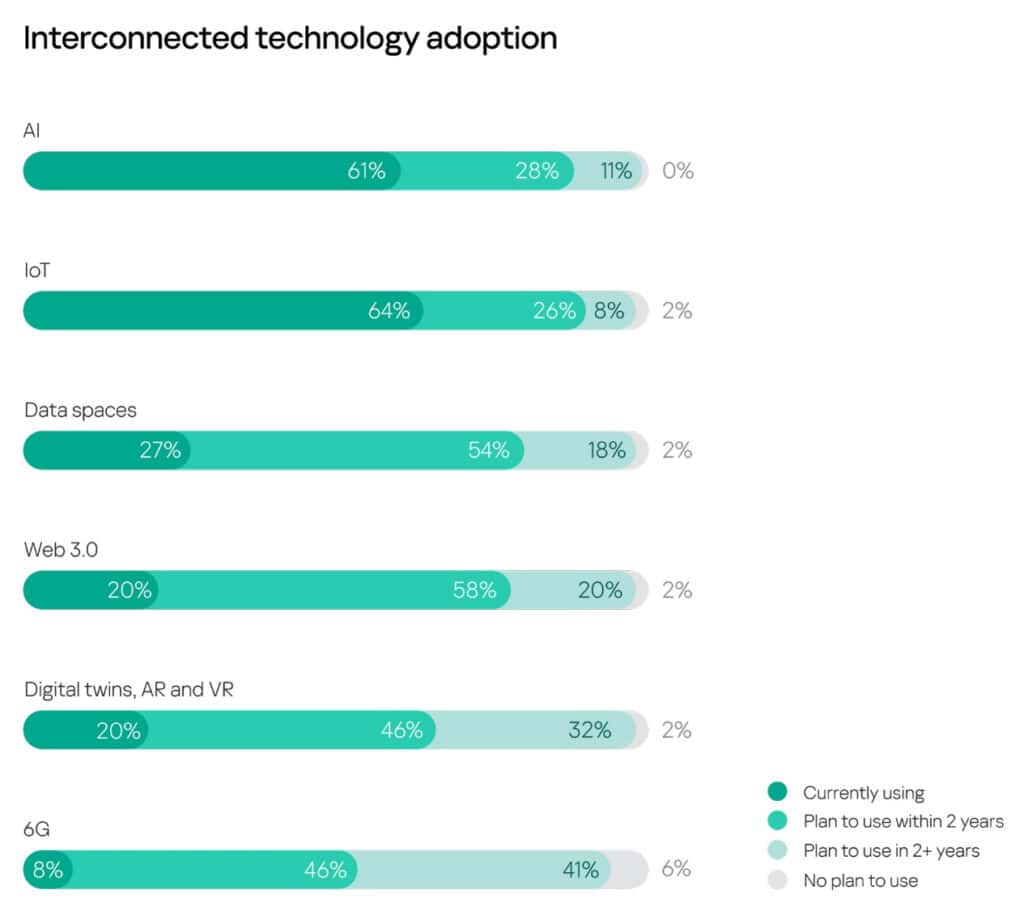AI and IoT are opening new vectors of cyberattack – Cyber Tech
Interconnected applied sciences are the rising community of units, techniques and purposes linked to the web and one another. They remodel enterprises, enabling them to assemble extra knowledge and automate processes. However in addition they carry new dangers and challenges when securing enterprise belongings and safeguarding prospects.
A latest Kaspersky research discovered that AI and IoT are already utilized by 61% and 64% of corporations respectively, whereas 28% and 26% of corporations plans to undertake them inside two years. Knowledge areas are utilized by 27% of companies, with greater than half (54%) aspiring to undertake them quickly.
Different interconnected applied sciences (digital twins, AR, VR, net 3.0, 6G), are utilized by 8-20% of corporations collaborating within the survey, however greater than 70% are contemplating integrating them into their enterprise processes quickly.
The increasing use of AI and IoT has the potential to reveal organisations to new vulnerabilities. In accordance with the analysis, 13-14% of organisations from the area assume AI and IoT are ‘very tough’ or ‘extraordinarily tough’ to guard, whereas solely 6% of the AI customers and 10% of the IoT house owners imagine their corporations are absolutely protected.
In accordance with Adrian Hia, managing director for Asia Pacific at Kaspersky, “Undoubtedly, new technological instruments play an important position in bettering the efficiencies and productiveness of enterprises within the area. Nonetheless, there are loopholes, notably in cybersecurity, that have to be addressed. Our latest research confirmed greater than half of the businesses are utilizing AI and IoT of their organisations, however 21% of them assume AI and IoT are considerably tough to guard. It reveals that there’s a expertise and information hole that must be patched with urgency.”
Suggestions going ahead

Given the size of change that interconnected applied sciences is prone to carry, organisations should develop a method to implement and defend them. Kaspersky recommends 4 efficient methods to make sure organisations are ready to guard interconnected applied sciences:
Undertake secure-by-design ideas. By integrating cybersecurity into every stage of the software program improvement lifecycle, secure-by-design software program and {hardware} grow to be resilient in opposition to cyberattacks, contributing to the general safety of digital techniques. Cyber Immune options primarily based on KasperskyOS, as an example, enable corporations to attenuate the risk floor and considerably lower the flexibility of cybercriminals to carry out a profitable assault.
Practice and upskill your workforce. Constructing a cyber-aware tradition requires a complete technique that empowers workers to realize information and put it into follow. With Kaspersky Skilled coaching, InfoSec professionals can advance their expertise and defend their corporations in opposition to assaults.
Improve your cybersecurity options and use centralized and automatic platforms corresponding to Kaspersky Prolonged Detection and Response (XDR). As corporations undertake interconnected applied sciences, they want cybersecurity options with extra superior options, enabling them to gather and correlate telemetry from a number of sources and supply efficient risk detection and speedy automated response.
As many AI options are constructed on containers, it’s essential to safe the infrastructure they’re built-in in with cybersecurity merchandise – corresponding to Kaspersky Container Safety – that enables corporations to detect safety points at each stage of the app lifecycle, from improvement to operation.
Meet rules to keep away from authorized issues or reputational injury, by making certain your cybersecurity follow meets altering requirements and authorized necessities.
The publish AI and IoT are opening new vectors of cyberattack appeared first on FutureIoT.
